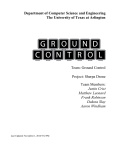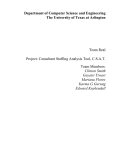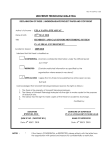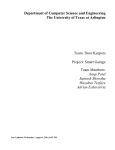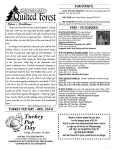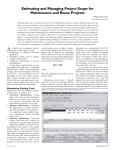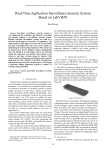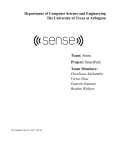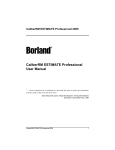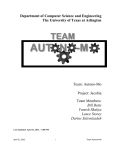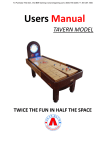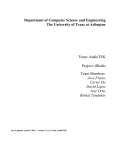Download System Requirements Specification
Transcript
Department of Computer Science and Engineering The University of Texas at Arlington TMMS Team: TK Force Team Members: Richard Sherrill David Odhiambo Huadong Feng Robert Castillo Last Updated: 7/28/13 System Requirements Specification Taekwondo Match Management System Table of Contents Table of Contents .........................................................................................................................................2 Document Revision History ........................................................................................................................5 List of Figures ..............................................................................................................................................6 List of Tables ...............................................................................................................................................7 1. Product Concept......................................................................................................................................8 1.1 Purpose and Use ............................................................................................................................8 1.2 Intended Audience ........................................................................................................................8 2. Product Description and Functional Overview.......................................................................................9 2.1 Features and Functions..................................................................................................................9 2.2 External Inputs and Outputs ..........................................................................................................9 2.3 Product Interfaces .......................................................................................................................10 3. Customer Requirements........................................................................................................................14 3.1 Audience Display ........................................................................................................................14 3.2 Start Screen .................................................................................................................................14 3.3 Control Panel...............................................................................................................................14 3.4 Match Setup ................................................................................................................................15 3.5 Test Mode ...................................................................................................................................15 3.6 Equipment Hit Detection ............................................................................................................15 3.7 Health Calculations .....................................................................................................................15 3.8 Penalties ......................................................................................................................................16 3.9 Score Modifiers ...........................................................................................................................16 3.10 Equipment Parts On/Off..............................................................................................................16 3.11 Match Log ...................................................................................................................................17 3.12 Administrator Display .................................................................................................................17 4. Packaging Requirements ......................................................................................................................18 4.1 Software ......................................................................................................................................18 4.2 User Manual ................................................................................................................................18 5. Performance Requirements ....................................................................................................................19 July 28, 2013 2 TK Force System Requirements Specification Taekwondo Match Management System 5.1 Start Program ..............................................................................................................................19 5.2 Life-bar Deduction Response......................................................................................................19 5.3 Recording Log.............................................................................................................................19 5.4 Response to Button Click ............................................................................................................20 5.3 Processing Force Data .................................................................................................................20 6. Safety Requirements ..............................................................................................................................21 7. Maintenance and Support Requirements ...............................................................................................22 7.1 Source Code ................................................................................................................................22 7.2 Software Modularity ...................................................................................................................22 7.3 Installing/Set up Product .............................................................................................................22 7.4 User Manual ................................................................................................................................23 8. Other Requirements ..............................................................................................................................24 8.1 Store Contestant Information ......................................................................................................24 8.2 Store Match Events .....................................................................................................................24 8.3 Store Country information ..........................................................................................................24 8.4 Store Match Statistics..................................................................................................................25 8.5 Calibration ...................................................................................................................................25 9. Acceptance Criteria ..............................................................................................................................26 9.1 Verify that the system displays the audience screen. ..................................................................26 9.2 Verify that the system runs in real time ......................................................................................27 9.3 Verify that the system saves data for Log ...................................................................................27 9.4 Verify that the system is user friendly ........................................................................................28 9.5 Verify that the system is accurately recording force...................................................................29 10. Use Cases ............................................................................................................................................30 10.1 Match Use Cases .........................................................................................................................30 10.2 Modification Use Cases ..............................................................................................................31 10.3 View Use Cases ..........................................................................................................................32 11. Feasibility Assessment........................................................................................................................34 11.1 Scope Analysis ........................................................................................................................34 11.2 Research ..................................................................................................................................34 11.3 Technical Analysis ..................................................................................................................34 11.4 Cost Analysis ...........................................................................................................................35 July 28, 2013 3 TK Force System Requirements Specification Taekwondo Match Management System 11.5 Resource Analysis ...................................................................................................................35 11.6 Schedule Analysis ...................................................................................................................35 11.7 Summary .................................................................................................................................39 12. Future Items ........................................................................................................................................40 12.1 Match Tournament ......................................................................................................................40 12.2 Support Myo ...............................................................................................................................40 12.3 Support Other Operating System ................................................................................................40 12.4 Save Match Video .......................................................................................................................40 13. Glossary ...............................................................................................................................................41 July 28, 2013 4 TK Force System Requirements Specification Taekwondo Match Management System Document Revision History Revision Revision Number Date 0.1 0.2 1.0 2.0 7/8/13 7/18/13 7/20/13 7/28/13 July 28, 2013 Description Rationale SRS First Draft SRS Second Draft Gate Review SRS Baseline Compiled all team member sections Integrate revisions from TK Force Integrated peer revisions Integrated Gate Review changes 5 TK Force System Requirements Specification Taekwondo Match Management System List of Figures Figure # Title Page # Figure 1-1: Conceptual Drawing 8 Figure 2-1: T.M.M.S. Data Flow 9 Figure 2-2: Administrator display for Game Setup 11 Figure 2-3: Administrator display for Game Control 12 Figure 2-4: Audience Display 13 Figure 10-1: Match Subsystem 30 Figure 10-2: Modification Subsystem 31 Figure 10-3: View Subsystem 32 July 28, 2013 6 TK Force System Requirements Specification Taekwondo Match Management System List of Tables Figure # Title Page # Table 2-1: External Inputs and Outputs 10 Table 9-1: Audience Screen Verification 26 Table 9-2: Real Time Verification 27 Table 9-3: Save Log data Verification 27 Table 9-4: User Friendly Verification 28 Table 9-5: Force Accuracy Verification 29 Table 11-1: Function Points, With Multiplier 36 Table 11-2: Jones First Order Influence Factor 36 Table 11-3: Adjusted Function Point Total 37 Table 11-4: Jones First Order Estimation 37 Table 11-5: COCOMO 81 Cost Drivers 38 July 28, 2013 7 TK Force System Requirements Specification Taekwondo Match Management System 1. Product Concept This section describes the purpose, use and intended user audience for the Taekwondo Match Management System. The TMMS is a software system that helps manage Taekwondo tournaments and communicates with special defense equipment to relay information to an audience and system administrators. 1.1 Purpose and Use The Taekwondo Match Management System will manage a match between two contestants utilizing the martial arts style, Taekwondo. The TMMS will allow administrators to set up match details about contestants, record match statistics, and display information to an audience about a Taekwondo match. The Taekwondo Match Management System will also communicate with special defense equipment that both contestants wear that can register force and location of attacks on each contestant. This will be used to display information to an audience and the administrators about a match. 1.2 Intended Audience The intended audience is Taekwondo gym owners that would like to quantify their training methods by hosting small sparring matches or would like to have additional data such as force and location of hits for their competitors. Additional audiences might include organizations that regularly host Taekwondo tournaments and are in need of an efficient match level management system. Figure 1-1: Conceptual Drawing July 28, 2013 8 TK Force System Requirements Specification Taekwondo Match Management System 2. Product Description and Functional Overview This section provides the reader with an overview of the Taekwondo Match Management System. The primary operational aspects of the product, from the perspective of end users, maintainers and administrators, are defined here. The key features and functions found in the product, as well as critical user interactions and user interfaces are described in detail. 2.1 Features and Functions The TMMS will consist of a software package that can be installed on any computer with the Windows Operating System. The TMMS will interface with defense equipment in order to record the statistics of matches and determine the force of attacks. The software will record the statistics and force of events by receiving data through a receiver on the defense equipment that each competitor will be wearing. This data will then be stored in an internal database so that it can be extracted when the data is needed. The TMMS will record the place a hit has occurred and the amount of force of that hit for administrators to view and will also affect a life bar that is viewable to an audience. TMMS will also display relevant competitor information to the audience and administrators. 2.2 External Inputs and Outputs The TMMS software will take in input when an administrator enters contestant information and sets up match details. When setting up the match details, a user will be assigned equipment that will be registered to that contestant. The registered equipment will send event (hit) information to the software to display to administrators and an audience. The data received from the equipment will be the location of events and the force of events. Admin. Display Competitor Defense Equipment TMMS Audience Display Figure 2-1: T.M.M.S. Data Flow July 28, 2013 9 TK Force System Requirements Specification Taekwondo Match Management System Table 2-1: External Inputs and Outputs Name Description Use Match Details The match details will set up the Input from Match setup screen initial settings for a Taekwondo Output to Administrator screen match. Defense Equipment T.M.M.S. will receive event data from the defense equipment. Input location of successful hits System will display a screen for administrators to setup matches, make changes, and view match details. Output defense equipment data System will display a screen for the audience to observe competitor life, time, and competitor name. Input data from defense equipment to alter life bars Administrator Display Audience display 2.3 Input force of successful hits Input match details Output real time life of competitors Product Interfaces The TMMS will be composed of an administrator display as well as an audience display. The information to be displayed on both screens will contain data from the defense equipment. The administrator display will allow users to specify match details and create mock up test modes in order to view data about matches. This data will include the force of a hit, as well as the location of the hit. The location of a hit can either be the chest or the head. It will also allow users to refer to previous match states. The audience display will show the competitors information, such as life, name, country, time remaining in match, and any penalties that have been applied to competitors. The figures below were provided by the sponsor. These mockups will be used as a guide for the user interface. The input fields, buttons, and screens will be represented in some form in the final product. The design layout and naming conventions may change to ensure ease-of-use. July 28, 2013 10 TK Force System Requirements Specification Taekwondo Match Management System Figure 2-2: Administrator display for Game Setup Figure 2-2 represents a screen that will be seen by the match administrators. It will allow them to input information relevant to the game, including: Contestant/Competitor name Contestant/Competitor country Number of rounds Round time Break time Medical time Health of the contestant/competitor (for the life bar feature) Penalty amounts o Jooyo – major penalty o Danjo – minor penalty Score modifiers o Combination hits o Head attacks/strikes Equipment setup for head and chest pads Threshold for minimum force required for a successful hit Fields shown in the figure, but not listed above, are subject to change in the final product. July 28, 2013 11 TK Force System Requirements Specification Taekwondo Match Management System Figure 2-3: Administrator display for Game Control Figure 2-3 represents a screen that will be seen by match administrators. This screen will be displayed after the input for a match has been accepted. The administrators will use this screen to monitor and control match events. Some of the controls include: Start/End match Assign penalty per competitor Medical time Match log Test mode Along with match controls, the administrators will be able to view the match information, such as life bar status, time remaining, and the test mode. The test mode will represent the status of the equipment and show the force of a strike. This mode is to ensure that the head and chest equipment is reporting strikes correctly. In this mockup, the test mode is represented by a graph of force vs. time. The controls mockup will be used as a guide for the final product’s control screen. Any button not mentioned is subject to change, or will be explained later in this document. July 28, 2013 12 TK Force System Requirements Specification Taekwondo Match Management System Figure 2-4: Audience Display Figure 2-4 is a representation of the audience display. The audience will be able to view the status of each competitor’s life bar, time remaining in the match, country represented, and round/match winner. The final product’s audience display will represent this information. July 28, 2013 13 TK Force System Requirements Specification Taekwondo Match Management System 3. Customer Requirements The section described consists of the requirements provided by our sponsor that must be implemented in order to provide a complete product. These requirements therefore will need to implement a maintenance interface for system administrators to set up and alter the system and display the status of competitors to an audience. 3.1 Audience Display 3.1.1 Description: During a match, the TMMS will provide a display with the competitor information to be viewed by the audience. Critical information to be displayed shall be name of competitors, life-bars, country, round and match victors, and time remaining for a match. 3.1.2 Source: William Sexton (Sponsor) 3.1.3 Constraints: None 3.1.4 Standards: Country codes determined by National Olympic Committee (NOC) 3.1.5 Priority: 1 – Critical 3.2 Start Screen 3.2.1 Description: When the system is started the software shall display a start screen showing the logo and name of the system. 3.2.2 Source: William Sexton (Sponsor) 3.2.3 Constraints: None 3.2.4 Standards: None 3.2.5 Priority: 2 – High 3.3 Control Panel 3.3.1 Description: The system shall have a control panel that allows a user to view details about a match, apply test mode for a match, apply minor and major penalties, apply medical to a match, and alter details about a match. 3.3.2 Source: William Sexton (Sponsor) 3.3.3 Constraints: None 3.3.4 Standards: None July 28, 2013 14 TK Force System Requirements Specification 3.3.5 3.4 Taekwondo Match Management System Priority: 1 – Critical Match Setup 3.4.1 Description: The system shall have a match setup screen to input contestant information, register equipment to contestant, and specify other match information. 3.5 3.4.2 Source: William Sexton (Sponsor) 3.4.3 Constraints: None 3.4.4 Standards: None 3.4.5 Priority: 1 – Critical Test Mode 3.5.1 Description: The system shall have a mode for users to view the forces that occur during a match and the times the forces occurred. 3.6 3.5.2 Source: William Sexton (Sponsor) 3.5.3 Constraints: None 3.5.4 Standards: None 3.5.5 Priority: 1 – Critical Equipment Hit Detection 3.6.1 Description: The system shall report successful hits as well as the force of those hits. 3.6.1.1 Force of successful hit: The system shall detect the force of a hit based on data sent from the Daedo equipment. This will determine the amount of life to be deducted from the life bar. 3.7 3.6.2 Source: William Sexton (Sponsor) 3.6.3 Constraints: Daedo fighting equipment must be operational. 3.6.4 Standards: None 3.6.5 Priority: 1 – Critical Health Calculations July 28, 2013 15 TK Force System Requirements Specification Taekwondo Match Management System 3.7.1 Description: The system shall calculate the remaining health of a competitor which will decrease based on the force of a successful hit (more force means more life deducted from the life bar), the number of penalties assigned to a fighter, and any modifiers that have been applied. 3.7.1.1 Modifiers: The system shall allow score modifiers to be implemented for a match. The modifiers will account for location of a strike (ex: head strikes will count more than body strikes) and any combination strikes (strikes that occur within a certain time frame). 3.8 3.7.2 Source: William Sexton (Sponsor) 3.7.3 Constraints: None 3.7.4 Standards: None 3.7.5 Priority: 1 – Critical Penalties 3.8.1 Description: The health of a fighter in the system can be affected by a penalty issued to a fighter and will contain two types of penalties major penalty (jooyo) and a minor penalty (danjo). 3.9 3.8.2 Source: William Sexton (Sponsor) 3.8.3 Constraints: None 3.8.4 Standards: None 3.8.5 Priority: 1 – Critical Score Modifiers 3.9.1 Description: The score modifiers will alter the amount of life decrease from a successful hit. 3.9.2 Source: William Sexton (Sponsor) 3.9.3 Constraints: None 3.9.4 Standards: None 3.9.5 Priority: 1 – Critical 3.10 Equipment Parts On/Off July 28, 2013 16 TK Force System Requirements Specification Taekwondo Match Management System 3.10.1 Description: The chest piece and head gear are separate entities that can be turned on or off and will report the status to the system. 3.10.2 Source: William Sexton (Sponsor) 3.10.3 Constraints: None 3.10.4 Standards: None 3.10.5 Priority: 1 – Critical 3.11 Match Log 3.11.1 Description: The system shall store the history of all scoreboard changing events and their attributes. If you select an event in the match log and hit accept, the match will be reverted to that point. 3.11.2 Source: William Sexton (Sponsor) 3.11.3 Constraints: None 3.11.4 Standards: None 3.11.5 Priority: 1 – Critical 3.12 Administrator Display 3.12.1 Description: During a match the TMMS will provide an administrator display that is independent of the audience display. This display will show details about the match that are not viewable to the audience. 3.12.2 Source: William Sexton (Sponsor) 3.12.3 Constraints: None 3.12.4 Standards: Country codes determined by National Olympic Committee (NOC) 3.12.5 Priority: 1 – Critical July 28, 2013 17 TK Force System Requirements Specification Taekwondo Match Management System 4. Packaging Requirements The system shall contain two parts: the first being the equipment that can interface with the software and shall be packaged according to the distributor’s requirements. The Taekwondo Match Management System software shall be packaged according to the requirements specified below. 4.1 Software 4.1.1 Description: The TMMS software shall be delivered as an installable software package. The medium that will contain the software will be delivered on CD/DVD as an executable. 4.1.2 Source: Team 4.1.3 Constraints: The operating system must be Windows 7 or above 4.1.4 Standards: None 4.1.5 Priority: 2 – High 4.2 User Manual 4.2.1 Description: The software shall contain a user manual that specifies how to use the system for monitoring Taekwondo matches. The user manual shall be located on the installation disk in soft copy form. 4.2.2 Source: Team 4.2.3 Constraints: The user manual will be written in English. 4.2.4 Standards: None 4.2.5 Priority: 4 – Low July 28, 2013 18 TK Force System Requirements Specification Taekwondo Match Management System 5. Performance Requirements This section indicates the performance requirements of how the product is expected to perform, including the speed and what is expected of the equipment’s software. 5.1 Start Program 5.1.1 Description: Once the user starts the program, it shall launch and be prepared within a short period of time. 5.1.2 Source: Team TK Force 5.1.3 Constraints: The launching time of the program will depend on the configuration of the hosting computer. 5.2 5.1.4 Standards: None 5.1.5 Priority: 2-High Life-bar Deduction Response 5.2.1 Description: The program shall reduce the life bar indicator on the screen when there is a successful hit detected by the receiver. The response delay from the hit to the screen will be minimal. 5.3 5.2.2 Source: TK Force 5.2.3 Constraints: None 5.2.4 Standards: None 5.2.5 Priority: 2-High Recording Log 5.3.1 Description: The program shall record the logs of a match immediately. 5.3.2 Source: TK Force 5.3.3 Constraints: None 5.3.4 Standards: None 5.3.5 Priority: 2-High July 28, 2013 19 TK Force System Requirements Specification 5.4 5.3 Taekwondo Match Management System Response to Button Click 5.4.1 Description: The program shall respond to any button clicks immediately. 5.4.2 Source: TK Force 5.4.3 Constraints: None 5.4.4 Standards: None 5.4.5 Priority: 2-High Processing Force Data 5.3.1 Description: When a hit is registered by the program, the force recorded from the hit will be retrieved from the Daedo equipment. 5.3.2 Source: TK Force 5.3.3 Constraints: Daedo equipment must be operational 5.3.4 Standards: None 5.3.5 Priority: 2-High July 28, 2013 20 TK Force System Requirements Specification Taekwondo Match Management System 6. Safety Requirements The TMMS software works in conjunction with defense equipment made by Daedo. TK Force assumes no responsibility for any injuries resulting from the use of the equipment in a match, or while training. July 28, 2013 21 TK Force System Requirements Specification Taekwondo Match Management System 7. Maintenance and Support Requirements This section will address the maintenance and support requirements for the Taekwondo Match Management System. It will address how we intend to maintain and support the system from website support to version update. 7.1 Source Code 7.1.1 Description: The source code for the project shall be available for review. The code will be documented and readable. 7.2 7.1.2 Source: TK Force 7.1.3 Constraints: None 7.1.4 Standards: None 7.1.5 Priority: 1 – Critical Software Modularity 7.2.1 Description: The software will be Object Oriented. This will allow the product to be updated or modified by a software developer. 7.3 7.2.2 Source: TK Force 7.2.3 Constraints: None 7.2.4 Standards: None 7.2.5 Priority: 1 – Critical Installing/Set up Product 7.3.1 Description: We will help the customer install and set up the product. 7.3.2 Source: TK Force 7.3.3 Constraints: Support for the product will end in December 2013 7.3.4 Standards: None 7.3.5 Priority: 1 – Critical July 28, 2013 22 TK Force System Requirements Specification 7.4 Taekwondo Match Management System User Manual 7.3.1 Description: A detailed user manual about the software will be made available on the installation disk. It will address the frequently asked questions and troubleshooting tips. 7.3.2 Source: TK Force 7.3.3 Constraints: N/A 7.3.4 Standards: The user manual will be in English. 7.3.5 Priority: 1 – Critical July 28, 2013 23 TK Force System Requirements Specification Taekwondo Match Management System 8. Other Requirements This section describes the requirements that have not been specified in any other section of the document. However, it does address requirements that add on to others requirements and are necessary for implementing a complete system. 8.1 Store Contestant Information 8.1.1 Description: The system shall store user information that corresponds to a contestant participating in a taekwondo match in a database. Must be able to store contestant name, must be able to store contestant country, and must be able to store equipment ID contestant is using 8.2 8.1.2 Source: TK Force 8.1.3 Constraint: None 8.1.4 Standards: None 8.1.5 Priority: 1 – Critical Store Match Events 8.2.1 Description: This information will be stored in a database and will correspond to events that affect the score in a single match. This information may also be used to return a match to a specific point in time. 8.2.1.1 Stored Events: Round event occurred, time event occurred (head shots, body shots, penalties (major/minor), referee stops match, etc..), the initiator of the event, the receiver of the event, the force of the event, the target (head and body), the target mod, the timing mod, and the score (calculated by force * target mod * timing mod) 8.3 8.2.2 Source: William Sexton (sponsor) 8.2.3 Constraints: None 8.2.4 Standards: None 8.2.5 Priority: 1 – Critical Store Country information 8.3.1 Description: This is a list of countries represented in the Olympic Games. Must be stored in a database as 3 letter country code, and must store corresponding country flag. July 28, 2013 24 TK Force System Requirements Specification 8.4 Taekwondo Match Management System 8.3.2 Source: William Sexton (sponsor) 8.3.3 Constraints: None 8.3.4 Standards: Country codes as determined by NOC (National Olympic Committee) 8.3.5 Priority: 2 – High Store Match Statistics 8.4.1 Description: This is a history of all the matches recorded by the software and must be stored in a database some relevant information to be stored are, who won the match, and what round the contestant won the match 8.5 8.4.2 Source: William Sexton (sponsor) 8.4.3 Constraints: None 8.4.4 Standards: None 8.4.5 Priority: 2 – High Calibration 8.4.1 Description: This will allow the force of hits on the equipment to be adjusted to ensure accuracy. 8.4.2 Source: TK Force 8.4.3 Constraints: None 8.4.4 Standards: None 8.4.5 Priority: 2 – High July 28, 2013 25 TK Force System Requirements Specification Taekwondo Match Management System 9. Acceptance Criteria This section describes the acceptance criteria for the Taekwondo Match Management System (TMMS). Based on the following criteria, the final system will be determined to be complete or incomplete by the sponsor. 9.1 Verify that the system displays the audience screen. 9.1.1 Requirement(s) addressed Table 9-1: Audience Screen Verification No. Requirements 3.1 Audience Display 3.7 Health Calculations 3.8 Penalties 3.9 Score Modifiers 5.2 Life-bar Deduction Response 9.1.2 Verification Procedure TMMS will be tested to ensure that the system can display the audience screen. After the match has been setup, the audience screen will be displayed on the monitor. July 28, 2013 26 TK Force System Requirements Specification 9.2 Taekwondo Match Management System Verify that the system runs in real time 9.2.1 Requirement(s) addressed: Table 9-2: Real Time Verification No. Requirements 5.2 Life-bar Deduction Response 5.3 Recording Log 5.4 Response to Button Click 9.2.2 Verification Procedure: When the system and equipment are online, the pad of each competitor will be struck to verify the life bar response. From the match log, the first event will be selected and applied to ensure the match log reverts to the initial match state. 9.3 Verify that the system saves data for Log 9.3.1 Requirement(s) addressed: Table 9-3: Save Log data Verification No. Requirements 3.11 Match Log 8.2 Store Match Events 8.3 Store Match Statistics 9.3.2 Verification Procedure: July 28, 2013 27 TK Force System Requirements Specification Taekwondo Match Management System TMMS will be tested and verified that the system responds to the match and store all the logs immediately. 9.4 Verify that the system is user friendly 9.4.1 Requirement(s) addressed: Table 9-4: User Friendly Verification No. Requirements 3.2 Start Screen 3.3 Control Panel 3.4 Match Setup 3.5 Test Mode 3.8 Penalties 3.9 Score Modifiers 3.11 Match Log 9.4.2 Verification Procedure: TMMS will be tested by the sponsor to verify ease of use. July 28, 2013 28 TK Force System Requirements Specification 9.5 Taekwondo Match Management System Verify that the system is accurately recording force 9.5.1 Requirement(s) addressed: Table 9-5: Force Accuracy Verification No. Requirements 3.5 Test Mode 3.7 Health Calculations 5.3 Processing Force Data 9.5 Calibration 9.3.2 Verification Procedure: TMMS will be tested after calibration to ensure the force of the hits is accurate. July 28, 2013 29 TK Force System Requirements Specification Taekwondo Match Management System 10. Use Cases We have identified three major subsystems and the Use Cases associated with them. The subsystems are Match, Modification, and View. The Use Cases for theses subsystems are Create Match, Start/Stop Match, Apply Penalty, Modify Score, Match Log, View Test Mode, and View Log File. 10.1 Match Use Cases Figure 10-1: Match Subsystem 10.1.1: Create Match Description: The user will have to input fighter information, penalty deductions, score modifiers, and equipment status before a match can start. System: Match Actor: User TUCBW: The user enters the fighters’ information and clicks the Create Match button. TUCEW: The screen displays the match information. 10.1.2: Start/Stop Match Description: The user will have to start and stop the match when necessary. System: Match Actor: User July 28, 2013 30 TK Force System Requirements Specification Taekwondo Match Management System TUCBW: The user presses the Start/Stop Match button. TUCEW: The screen displays the current status of the match. 10.2 Modification Use Cases Figure 10-2: Modification Subsystem 10.2.1: Apply Penalty Description: During a match, the user may have to administer a penalty to one of the fighters. System: Modification Actor: User TUCBW: The user presses the appropriate penalty button. TUCEW: The points are deducted from the fighter’s score. July 28, 2013 31 TK Force System Requirements Specification Taekwondo Match Management System 10.2.2: Modify Score Description: At the direction of the official, the user will need to modify the score of a fighter. System: Modification Actor: User TUCBW: The user adjusts the fighter’s score on the screen. TUCEW: The screen displays the adjusted score. 10.2.3: Log Match Description: The user will have the option to view a logged event from the Match Log file and apply the previous events as the current. System: Modification Actor: User TUCBW: The user presses the Log button and selects a logged event. TUCEW: The screen displays the information from the logged event. 10.3 View Use Cases Figure 10-3: View Subsystem July 28, 2013 32 TK Force System Requirements Specification Taekwondo Match Management System 10.3.1: View Test Mode Description: The user will be able to view the test mode to ensure the equipment and system is recording hits at the correct force and time. System: View Actor: User TUCBW: The user clicks the Test Mode button. TUCEW: The screen displays the Test Mode screen. 10.3.2: View Log File Description: The user may need to view previous events from the current match. System: View Actor: User TUCBW: The user presses the Log button. TUCEW: The screen displays the current Log File. July 28, 2013 33 TK Force System Requirements Specification Taekwondo Match Management System 11. Feasibility Assessment This section consists of an assessment of the following six components: scope analysis, research completed/remaining; technical analysis; cost analysis, resource analysis; and schedule analysis. 11.1 Scope Analysis We have analyzed the scope of the project, as well as our team abilities, and concluded that we will be able to complete the minimum acceptable requirements for this project. These requirements include realtime events, data saving and storage, user-friendliness, and displays for the audience and match administrators. The real-time events include registering a hit, the force of the hit, the location of the hit (head or body), and the event log. The data being saved and stored are match events, match results, and country flags used to further identify the fighters. The user-friendliness is also critical because the match administrators are normally volunteers that will have negligible experience with our software. The layout must make sense and be navigated by anyone. The last critical requirement is the display setup. The match administrators must be able to view the controls and match status on one screen, while the audience should only see the match status. 11.2 Research We have begun researching the Daedo fighting equipment that our system will work with. The results from this research will allow us to understand what type of data is being received so we can translate that to data that we can use for our project. We have found one other project similar to ours that has been completed which may be able to help us with portions of ours. Additional research has been performed on the materials that make up the fighting equipment, and the transmitter/receiver for the equipment. We have performed this research as a backup plan, in case the Daedo equipment cannot be integrated into our system. 11.3 Technical Analysis There are three technical components to our system: the wireless receiver, the display setup, and the user interface. The wireless receiver obtains data from the fighting equipment and sends it to the computer. The type of data coming from the receiver is still unknown, and must be researched to integrate into the system. The display setup requires the audience and the match administrators to view two different screens. We have discussed using Java or C# to implement this feature, depending on which has a more robust library. July 28, 2013 34 TK Force System Requirements Specification Taekwondo Match Management System The user interface will allow the match to be setup and managed. The equipment components can be manipulated from here, and match events can be viewed and assigned. It will also be required to make adjustments in real time and revert back to a previous state, if necessary. The system, as it currently stands, does not require any additional hardware components. The software will be designed to be installed on any Windows computer. The fighting equipment is its own system, and we will not be making any modifications to it. The team will need to retrieve information from the sponsor about the equipment, and may have to contact Daedo to provide any additional information about the data retrieval aspect of the equipment. The team has a variety of technical skills that should allow us to resolve any technical issues encountered. 11.4 Cost Analysis The prototype for the system will incur no financial cost. The fighting equipment has been procured by the sponsor and the software doesn’t require any specialized hardware to run. 11.5 Resource Analysis Team TK Force consists of two software engineers, one computer scientist, and one computer engineer. The resources necessary to complete this project on schedule include time management, logical task assignments, scheduling, document collaboration and integration, programming skills, and networking. If there are no issues with the Daedo fighting equipment, we will be able to complete the project on schedule. The team has experience developing graphical user interfaces and using multiple programming languages. The team also has experience in detailed design and development of a non-trivial system. The team has little, or no, experience in networking, which can affect how easily it will be to retrieve the data from the wireless receiver and translate that information into usable data for the system. The team also does not have experience with Microsoft Project and must learn to utilize it for the success of the project. 11.6 Schedule Analysis To estimate our schedule, the team has used multiple estimation techniques. We chose to use function points, Jones First Order Estimation, and COCOMO 81 to provide an initial estimate. Other techniques may be used in the future for additional estimates that will give us a better idea of the schedule. 11.6.1 Function Points Function points are used to estimate the size of a program. We analyzed the inputs, outputs, inquiries, logical internal files, and external interface files which gives us the function point total. July 28, 2013 35 TK Force System Requirements Specification Taekwondo Match Management System Table 11-1: Function Points, With Multiplier Low Complexity Medium Complexity High Complexity Number of Inputs 9 0 6 Number of Outputs 4 15 14 Inquiries 0 12 0 Logical Internal Files 0 0 0 External Interface Files 0 0 0 Unadjusted Function Points 60 To find the influence factor, we used Jones First Order Influence Factor. Table 11-2: Jones First Order Influence Factor Influence Multiplier July 28, 2013 Data Communications 2 Distributed Data processing 2 Performance 5 Heavily used configurations 2 Transaction Rate 1 On-Line Data Entry 0 End-user Efficiency 5 On-Line Update 0 36 TK Force System Requirements Specification Taekwondo Match Management System Complex processing 3 Reusability 5 Installation ease 4 Operational ease 4 Multiple sites 3 Facilitate change 5 Total 41 Influence Factor 1.06 When multiplied by the Unadjusted Function Point Total, this gives us our Adjusted Function Point Total, which will assist in our estimation. Table 11-3: Adjusted Function Point Total Adjusted Function Point Total 60 * 1.06 63.6 11.6.2 Effort Estimation Calculating the Adjusted Function Point Total allows us to use Jones First Order Estimation for a Business-Class project. Table 11-4: Jones First Order Estimation Best Case Average Worst Case Business-Class 0.41 0.43 0.46 Calendar Months 5.49 5.96 6.75 11.6.3 COCOMO 81 Model July 28, 2013 37 TK Force System Requirements Specification Taekwondo Match Management System We used the COCOMO 81 Model to provide additional estimates on our schedule. We derived a very rough estimate of single lines of code (SLOC) based on previous projects that had similar aspects implemented. Table 11-5: COCOMO 81 Cost Drivers Ratings Score Required software reliability High 1.15 Size of application database Low 0.94 Complexity of the product Nominal 1.00 Run-time performance constraints Very High 1.30 Memory constraints Nominal 1.00 Volatility of the virtual machine environment Low 0.87 Required turnabout time Nominal 1.00 Analyst capability Nominal 1.00 Applications experience Low 1.13 Software engineer capability Nominal 1.00 Virtual machine experience Low 1.10 Programming language experience Nominal 1.00 Application of software engineering methods Nominal 1.00 Use of software tools Nominal 1.00 Product Attributes Hardware attributes Personnel attributes Project attributes July 28, 2013 38 TK Force System Requirements Specification Taekwondo Match Management System Required development schedule Nominal 1.00 EAF 1.52 KSLOC 4.00 Effort Applied (man-months) 21.54 Development Time (calendar months) 7.32 11.7 Summary From the analysis, we can see that this project is estimated to be complete in approximately six or seven months, and Senior Design will span six months. The team has a responsibility to meet the deadlines given by the instructor, so the project must be complete by the end of the second semester. However, the analysis was performed with all of the requirements in mind. To finish the project on time, we may have to push some non-critical functionality to future versions of the project. It should be noted that these estimates may be off. As the project continues forward, TK Force will reassess certain requirements to obtain a better estimate. At this point in time, the estimates can only give us a rough idea regarding the actual time required to complete the full set of requirements. July 28, 2013 39 TK Force System Requirements Specification Taekwondo Match Management System 12. Future Items 12.1 Match Tournament 12.1.1 Requirement Description: The program shall support multi-match instead of only monitoring one match. The program will be receiving data from many sets of equipment and monitor each set’s match at the same time. 12.1.2 Constraint: Lack of knowledge on receiving data from multi sets. More cost of money and time. 12.2 Support Myo 12.2.1 Requirement Description: The program shall support the Myo armband, the referee shall be able to apply penalties, pauses the match, call medical, etc. while wearing Myo. 12.2.2 Constraint: Myo has not been released. Lack of knowledge of how Myo works. More cost of money and time. 12.3 Support Other Operating System 12.3.1 Requirement Description: The program shall be able to work on Mac OS, Linux and other common operating system. 12.3.2 Constraint: More cost of money and time. 12.4 Save Match Video 12.3.1 Requirement Description: The program shall be able to save the video that has been recorded during the match into an .mp4 file. 12.3.2 Constraint: More cost of money and time. July 28, 2013 40 TK Force System Requirements Specification Taekwondo Match Management System 13. Glossary Daedo – The manufacturer of the fighting equipment TUCBW- “The Use Case Begins When” TUCEW- “The Use Case Ends When” Myo- armband that detects forearm movement July 28, 2013 41 TK Force









































